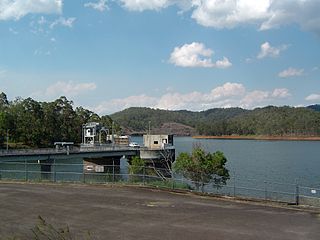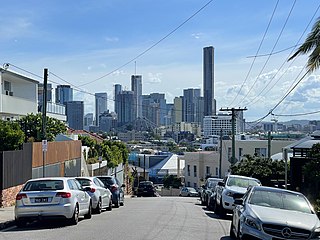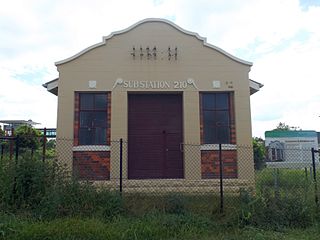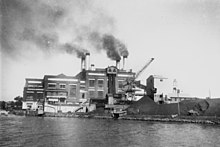
The Wivenhoe Power Station is situated between the Splityard Creek Dam and Lake Wivenhoe. The Splityard Creek Dam is located in hills adjacent to Lake Wivenhoe and is about 100 metres (330 ft) above it. The power station is the only pumped storage hydroelectric plant in Queensland.

The recorded History of Brisbane dates from 1799, when Matthew Flinders explored Moreton Bay on an expedition from Port Jackson, although the region had long been occupied by the Yugara and Turrbal aboriginal tribes. The town was conceived initially as a penal colony for British convicts sent from Sydney. Its suitability for fishing, farming, timbering, and other occupations, however, by 1838, pressure from free settlers led to Brisbane's designation as an area for free settlement in 1842, opening it to non-convict immigrants and beginning its tranformation into a commerical and agriculttural hub. The town became a municipality in 1859 and a consolidated metropolitan area in 1924. Brisbane encountered major flooding disasters in 1893, 1974, 2011 and 2022. Significant numbers of US troops were stationed in Brisbane during World War II. The city hosted the 1982 Commonwealth Games, World Expo 88, and the 2014 G20 Brisbane summit.

New Farm is an inner northern riverside suburb in the City of Brisbane, Queensland, Australia. In the 2021 census, New Farm had a population of 12,197 people.
The Paddington tram depot fire occurred on the night of 28 September 1962, and was one of the largest fires in Brisbane's history. As well as the depot, 67 trams were destroyed, 20% of the city's fleet. The destruction of the depot is generally seen as the beginning of the end for Brisbane's tram system, providing the justification for the subsequent closure of four tram routes and the gradual encroachment of bus operation on other tram routes, with the final closure of the tram system occurring on 13 April 1969.

The culture of Brisbane derives from Australian culture and incorporates a strong history in the performing arts, music and sport.

Teneriffe is an inner suburb of Brisbane, Queensland, Australia, 2.5 kilometres (1.6 mi) north-east of the CBD. In the 2021 census, Teneriffe had a population of 5,520 people.

Paddington is an inner suburb in the City of Brisbane, Queensland, Australia. In the 2021 census, Paddington had a population of 9,063 people.

The Brisbane tramway network served the city of Brisbane, Australia, between 1885 and 1969. It ran on standard gauge track. The electric system was originally energised to 500 volts, and subsequently increased to 600 volts. All tramcars built in Brisbane up to 1938 had an open design. This proved so popular, especially on hot summer nights, that the trams were used as fundraisers and often chartered right up until the last service by social groups.

Mount Crosby pumping station is a heritage-listed pumping station and weir at Stumers Road, Mount Crosby, City of Brisbane, Queensland, Australia. It is located on the Brisbane River and extends into Chuwar on the other side of the river. The facility supplies water to Brisbane and nearby cities and towns within the SEQ Water Grid. It was originally designed by Charles H McLay and built from 1891 to 1892. The historic parts of the facility were added to the Queensland Heritage Register on 25 October 2019. It is also listed on the Brisbane Heritage Register, together with numerous associated facilities which were not included in the state heritage listing.

Manors Power Station or the Tramways Generating Station is a former coal-fired power station located in the Manors district of the city centre of Newcastle upon Tyne, Tyne and Wear in North East England. The station's turbine hall and other remaining buildings are Grade II listed.

The provision of electricity in Queensland required a considerable degree of pioneering, innovation, and commitment. Queensland proved to be a pioneer in the supply of electricity in Australia, with the first public demonstration in Australia, the first recorded use for public purposes in the country, the first Parliament House in Australia and the first commercial operations in Australia all occurring in Brisbane.

The Tennyson Power Station was a coal-fired power station in Tennyson, Brisbane, Queensland, Australia, which operated between 1953 and 1986. The power station was the second major plant constructed for Brisbane, the first being the New Farm Powerhouse. It had an installed capacity of 250 MW.

Windsor Town Quarry Park and Tramways Substation No. 6 is a heritage-listed former quarry with electrical substation at 356 Lutwyche Road, Windsor in the City of Brisbane, Queensland, Australia. It was built from c. 1926 to c. 1928. The park and substation were added to the Queensland Heritage Register on 31 May 2005. There is another, larger substation building, Tramways Substation No. 13 which was designed by Frank Gibson Costello and became operational in June 1949.

Brisbane City Council Tramways Substation No. 9 is a heritage-listed electrical substation at 97 Wynnum Road, Norman Park, Queensland, Australia. It was built in 1935. It was added to the Queensland Heritage Register on 5 August 2003.

Brisbane City Council Tramways Substation No. 8 is a heritage-listed electrical substation at 134 Kedron Park Road, Wooloowin, City of Brisbane, Queensland, Australia. It was built from 1934 to 1937. It was added to the Queensland Heritage Register on 5 August 2003.

Coorparoo Substation No. 210 is a heritage-listed electrical substation at 12 Main Avenue, Coorparoo, City of Brisbane, Queensland, Australia. It was designed by Reyburn Jameson and built in 1930 by A. Mason. It is also known as Substation 10. It was added to the Queensland Heritage Register on 1 August 2005.

Paddington Tramways Substation is a heritage-listed former electrical substation at 150 Enoggera Terrace, Paddington, City of Brisbane, Queensland, Australia. It was designed by Roy Rusden Ogg and built from 1929 to 1930. It was added to the Queensland Heritage Register on 22 March 1993.
The electricity supply in Brisbane has been an important part of the economic and social development of the city of Brisbane, Queensland, Australia.
A network of Brisbane tramways substations, supplied from the Brisbane Powerhouse, were developed by Brisbane City Council after they took over the Brisbane Tramways system from Brisbane Tramways Company (BTCo). The new powerhouse and substations were needed, as BTCo had not adequately invested enough into the electricity network to keep the system running efficiently. Brisbane City Council maintained this electricity network from 1927 until 1969, when the decision was made not to have Trams in Brisbane, and the network was shut down and decommissioned.
Endrim, Woodstock Road tram shed, and tram track are a heritage-listed group consisting of a house, a tramway and a tramway stop at 6 & 28 Woodstock Road, Toowong, City of Brisbane, Queensland, Australia. They were built in 1906 by the Brisbane Tramways Company Limited. Endrim is also known as Arlington and "Boss" Badger's residence. It was added to the Queensland Heritage Register on 23 March 2018.




















